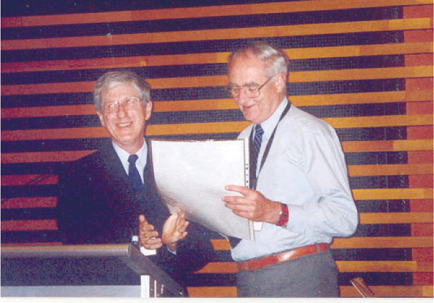Polymer Special Issue Foreword
David Lewis AA Research Manager, Materials Technology, SOLA Optical R&D, Lonsdale 5160 SA, Australia. Email: dlewis@sola.com.au

David Lewis obtained a B.Sc. and Ph.D. in chemistry from the University of Queensland with Prof. Jim O’Donnell and in 1986 he started a postdoc with Profs. Tom Ward and Jim McGrath at Virginia Tech. Following 10 years at the IBM T. J. Watson Research Centre in New York, he joined SOLA Optical in Adelaide in 1998. David is currently Research Manager, Materials Technology at the SOLA R&D Centre in Adelaide. |
Australian Journal of Chemistry 58(6) 377-378 https://doi.org/10.1071/CH05123
Submitted: 13 May 2005 Accepted: 13 May 2005 Published: 14 June 2005
I am delighted that the Australian Journal of Chemistry and the RACI Polymer Division have again combined their efforts with an issue devoted to a representative selection of papers from the 27th Australasian Polymers Symposium (APS) held in Adelaide in late 2004.
Polymer science is entering a new and exciting phase—gone are the days when the primary aim of polymers was a cost and weight saving over the metals they were sought to replace. Recent advances in living polymerization, dendrimers, and understanding of polymer behaviour now provide a means to ‘build’ a very wide range of molecular and supra-molecular structures that have the capability to deliver very specific functions when stimulated appropriately. The design and understanding of these nanostructures will result in a merging of the physical and biological sciences, providing a fertile ground for innovation and discovery that could impact every aspect of our lives.
Nature, of course, is the first and best polymer technologist. The remarkable biological polymeric structures that form and replicate ‘by themselves’ is both fascinating as well as being essential for life. The ability to synthetically create three-dimensional structures has applications from artificial organs to water purification. In this issue, Volga Bulmus[1] and Frank Caruso and John Quinn[2] discuss planar and three-dimensional structures that interact with the environment to deliver drugs, and Dave Hill and colleagues[3] report the use of poly(HEMA-co-THFMA) to model drug release (Hill was also presented with the RACI Distinguished Fellowship by David Edmonds; Fig. 1). Virgil Percec and coworkers[4] report a series of new dendritic dipeptides that self-assemble to mimic porous transmembrane proteins. Such proteins can facilitate selective ion and water transport through a membrane.

|
The use of deliberately engineered nanostructures as reinforcing agents, templates or the active component in a system is exploding around the world. Foamed structures based on clay nanoparticles (David Tomasco et al.[5]) and nanoparticles with oligomeric chains grown using living free-radical polymerization (Barner and coworkers[6]) are examples. RAFT is reviewed (Graeme Moad, Ezio Rizzardo, & San Thang[7]) and is extended to fluorinated compounds (Barner-Kowollik and colleagues[8]) and a range of controlled structure polymers based on dendritic scaffolds (Barner-Kowollik and colleagues[9]) are other examples of the application of living free-radical polymerization.
As the complexity and elegance of supramolecular structures increase, it is critical that characterization methods can keep pace. This is made more important by the potential for structural damage caused by the measurement probe itself. The use of soft X-ray spectro-microscopy (Adam Hitchcock and coworkers[10]) is very relevant and topical as a new synchrotron facility is being built in Australia, which will enable Australian scientists to work locally.
Silicon-based materials are incredibly versatile materials with applications from hair care products to caulking compounds to interlayer dielectrics in semiconductors and coatings of ophthalmic lenses. Corona treatment of the silicone surface to allow paints and inks to adhere (Michael Owen[11]) as well as evidence for an active role in scar remediation (Graeme George and colleagues[12]) are diverse examples of the role silicon polymers can play.
The modification and utilization of naturally occurring polymers is both technically interesting and commercially important. Gilbert et al.[13] present a novel approach to displace the proteins from natural rubber latexes to reduced allergic reactions, while Avérous et al.[14] discuss progress in biodegradable polymers based on plasticized starch.
An important part of the APS is the Treloar Prize, awarded for the best oral and poster presentations by students and presenters aged under 30 at the time of the conference, based on content and presentation. The award is named in honour of Ted Treloar who was dedicated to promoting our future through students, and this year the award was sponsored by the Australian Journal of Chemistry. John Quinn and Georgina Such shared the prize for best oral presentation, while Raymond Joso won the prize for best poster. Papers from Quinn[2] and Joso[6] can be found on pages 442 and 468, respectively.
I congratulate all the contributors to this issue. It is an exciting and diverse collection of cutting-edge polymer science that reflects the extremely high standard of presentation at the 27th APS.
[1]
V. Bulmus,
Aust. J. Chem. 2005, 58, 411.
| Crossref | GoogleScholarGoogle Scholar |
| Crossref | GoogleScholarGoogle Scholar |
| Crossref | GoogleScholarGoogle Scholar |
| Crossref | GoogleScholarGoogle Scholar |
| Crossref | GoogleScholarGoogle Scholar |
| Crossref | GoogleScholarGoogle Scholar |
| Crossref | GoogleScholarGoogle Scholar |
| Crossref | GoogleScholarGoogle Scholar |
| Crossref | GoogleScholarGoogle Scholar |
| Crossref | GoogleScholarGoogle Scholar |
| Crossref | GoogleScholarGoogle Scholar |
| Crossref | GoogleScholarGoogle Scholar |
| Crossref | GoogleScholarGoogle Scholar |
| Crossref | GoogleScholarGoogle Scholar |



